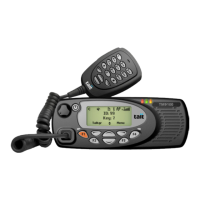TM9100 Service Manual Description 51
© Tait Electronics Limited August 2005
2.5.2 Digital Baseband Processing
Custom Logic The remainder of the receiver processing up to demodulation is performed
by custom logic. The digitized quadrature signal from the RF hardware is
digitally down-converted to a zero IF and channel filtering is performed at
baseband. Different filter shapes are possible to accommodate the various
channel spacings and data requirements. These filters provide the bulk of
adjacent channel selectivity for narrow-band operation. The filters have
linear phase response so that good group-delay performance for data is
achieved. The filters also decimate the sample rate down to 48kHz.
Custom logic also performs demodulation, which is multiplexed along with
AGC and amplitude data and fed via a single synchronous serial port to the
DSP. The stream is demultiplexed and the demodulation data used as an
input for further audio processing.
Noise Squelch The noise squelch process resides in the DSP. The noise content above and
adjacent to the voice band is measured and compared with a preset
threshold. When a wanted signal is present, out-of-band noise content is
reduced and, if below the preset threshold, is indicated as a valid wanted
signal.
RSSI Receive signal strength is measured by a process resident in the DSP.
This process obtains its input from the demodulator (RF signal magnitude
value) and from the AGC (present gain value). With these two inputs and a
calibration factor, the RF signal strength at the antenna can be accurately
calculated.
Calibration The following items within the receiver path are factory-calibrated:
■ front-end tuning
■ AGC
■ noise squelch
■ RSSI
Information on the calibration of these items is given in the on-line help
facility of the calibration application.

